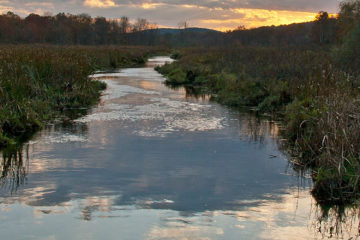Explanation of High Gradient Macroinvertebrate Index
The benthic macroinvertebrate samples are scored using the High Gradient Macroinvertebrate Index (HGMI). This index was developed for northern New Jersey, above the geologic fall-line including the following ecoregions: North Central Appalachians, Central Appalachian Ridges and Valleys, Northeastern Highlands, Northeastern Coastal Zone, and Northern Piedmont. This protocol evaluates a 100 organism subsample identified down to the genus level on seven criteria:
-
- Total number of genera_adj = 26.53 + Metric – [22.776 + 4.173*log10(areasqkm)]
- Percent Genera that are not insects
- Percent sensitive EPT (excluding Hydropyschidae, including Diplectrona)_adj = 37.49 + Metric – [49.922 – 13.800*log10(areasqkm)]
- Number of scraper genera_adj = 5.44 + Metric – [3.889 + 1.724*log10(areasqkm)]
- Hilsenhoff Biotic Index_adj = 4.23 + Metric – [3.407 + 0.918*log10(areasqkm)]
- Number of New Jersey TALU attribute 2 genera
- Number of New Jersey TALU attribute 3 genera
adj (Adjusted metric value) = Mean_reference + Metric_observed – Metric_predicted, where predictions are based on linear regression analysis of reference metric values on catchment size.
Assessment Category Index Score Regulatory Threshold
Excellent 63 – 100 Full Attainment
Good <63 – 42 Full Attainment
Fair <42 – 21 Non-Attainment
Poor <21 Non-Attainment
Attributes
- Excellent: Minimal changes in structure of biological community and minimal changes in ecosystem function. Virtually all native taxa are maintained with some changes to biomass and/or abundance; ecosystem functions are fully maintained within the range of natural variability.
- Good: Some evident changes in structure of the biotic community and minimal changes in ecosystem function. Some changes in structure due to loss of some rare native taxa; shifts in relative abundance of taxa but sensitive-ubiquitous taxa are common and abundant; ecosystem functions are fully maintained.
- Fair: Moderate to major changes in structure of biological community and moderate changes in ecosystem function. Sensitive taxa are markedly diminished; conspicuously unbalanced distribution of major groups from that expected; organism condition shows signs of physiological stress; system function shows reduced complexity.
- Poor: Extreme changes in structure of biological community and major loss of ecosystem function. Extreme changes in structure; wholesale changes in taxonomic composition; extreme alterations from normal densities and distributions; organism condition is often poor; ecosystem functions are severely altered.
For more information on how this index was developed, please read this REPORT.
Explanation of Line Graphs
The blue, green, orange, and red lines on the line graphs serve as reference for you to determine if a stream site was impaired during a specific year.
The blue solid line indicates the maximum score for an excellent rating. The blue line and the green line illustrate the boundaries for an excellent rating. If a data point falls above the green line, the stream site for that specific year was excellent.
The green line and the orange dashed line illustrate the boundaries for a good rating. If a data point is on the green line or falls between the green line and the orange dashed line, the stream site for that specific year was good.
The the orange dashed line and the red dashed line illustrate the boundaries for a fair rating. If a data point is on the orange dashed line or falls between the orange dashed line and the red dashed line, the stream site for that specific year was fair.
The red dashed line indicates the upper boundary for a poor rating. If a data point is on the line or falls below the red dashed line, the stream site for that specific year was poor.
High Gradient Macroinvertebrate Index Score Key
Explanation of Habitat Score
Habitat Score Stream habitat is evaluated according to a US EPA Rapid Bio-assessment Protocol. Using narrative in the protocol as guidance, ten parameters that pertain to different habitat attributes are visually assessed. Epifaunal Substrate Cover/Available Cover, Embeddedness, Velocity/Depth Regimes, Sediment Deposition, Channel Flow Status, Channel Alteration, Frequency of Riffle are assigned a score between 0 and 20. The left and right banks of the stream are assessed separately and are assigned scores between 0 and 10 for Bank Stability, Bank Vegetative Protection, and the Riparian Vegetative Zone Width. The final habitat score is the sum of the ten parameters (maximum = 200).
Explanation of Habitat Rating
Habitat Rating depends on the total Habitat Score.
|
Habitat Rating |
Values |
|
Optimal |
160 – 200 |
|
Sub-optimal |
110 – 159 |
|
Marginal |
60 – 109 |
|
Poor |
<60 |
Strategic Plan
In 2012, RHA developed a five-year strategic plan to improve and make our stream monitoring program more comprehensive. Our goal is to have a minimum of one stream monitoring site in each of our 52 subwatersheds. Part of the plan involves retiring redundant monitoring sites in subwatersheds with a high a concentration of sites. The criteria for retirement:
- The site was non-impaired
- The site was not located near the mouth of the subwatershed
- The site was not monitoring a specific source of pollution
- Volunteers were not committed to monitoring the site




